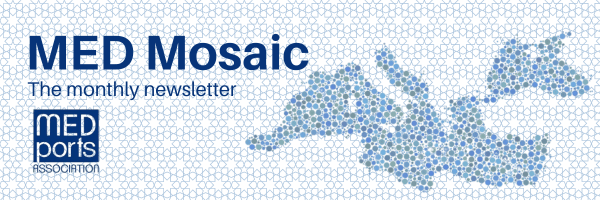Issue 17
HOT SEAT:
Interview with Mme Khaoula Beladkhdhar, General Director, OMMP – Office de la Marine Merchande et des Ports and Executive Vice President of the MEDPorts Association
An Overview of Tunisian Ports

Issue 17
HOT SEAT:
Interview with Mme Khaoula Beladkhdhar, General Director, OMMP – Office de la Marine Merchande et des Ports and Executive Vice President of the MEDPorts Association
An Overview of Tunisian Ports
As the newly appointed Chief Executive Officer of OMMP, my priorities for the coming years are firmly anchored in advancing Digital transformation and ports automation, ensuring reconciliation between cities and ports in facilities, port safety and security, enhancing energy efficiency, and infrastructure development in a sustainable manner. Our first objective is to enhance port infrastructure and operational efficiency to support the rising volume of trade. This will include strategic investments in advanced technology and equipment to streamline port operations. Secondly, we aim to deepen partnerships with global shipping lines and logistics providers to boost the connectivity of Tunisian ports with major international trade routes through regular sea lines.
In addition, we are committed to sustainable and eco-friendly practices to minimize the environmental impact of port activities. This will involve adopting green technologies and expanding the use of renewable energy sources. Furthermore, we will focus on building the skills and capabilities of our workforce through continuous training and development, ensuring that our staff is well-equipped to meet the evolving demands of the maritime industry.
We look forward to working with all stakeholders to realize these objectives as part of our strategic vision for 2040 under “ the “Master Plan Horizon 2040”, which was initiated in January 2024. This comprehensive plan sets out key goals to drive the continued growth and modernization of Tunisian ports.
As the executive vice-chair of MEDPorts, OMMP is well-positioned to drive fruitful cooperation with fellow members and promote collective advancements across the Mediterranean port sector. By working together, we aim to strengthen connectivity, knowledge-sharing, and best practices among member ports, ultimately enhancing operational efficiency, safety, and sustainability across the region.
We expect this role to facilitate joint initiatives in areas, such as digital transformation and Smart ports, green port development, and workforce training—key priorities for both OMMP and MEDPorts. Furthermore, this position provides us with a unique platform to actively contribute to policy discussions and initiatives that support the resilience and competitiveness of Mediterranean ports in global trade. Holding the executive vice-chair not only reflects OMMP’s commitment to these shared goals but also allows us to foster meaningful partnerships that benefit all MEDPorts members and drive sustainable growth for the Mediterranean’s maritime economy.
Actually, no significant effect was registered, but there may be more traffic at Tunisian ports as shipping companies search for alternate routes for their cargo if ships are deviating from the Red Sea’s conventional routes to the Cape of Good Hope. Ports in Tunisia may profit from higher port fee income as a result.
If there is a large influx of ships, Tunisian ports may encounter difficulties, which could result in traffic congestion and delays in the handling of cargo and in order to handle more traffic, infrastructure and logistical capabilities might need to be evaluated and perhaps improved.
The degree to which Tunisian ports adjust to these developments will determine the overall economic impact. If the difficulties brought on by the influx of new ships are properly handled, increased shipping activity may lead to more jobs and economic activity in the port cities. It is also worth noting that environmental issues and regulatory difficulties, especially with regard to customs processes and maritime safety, can also result from increased shipping traffic.
Indeed, being a woman in a top management position in the traditionally male-dominated port and shipping industry presents a unique challenge. However, I see this as an opportunity rather than a barrier. Leading OMMP allows me to bring a fresh perspective and commitment to inclusivity, proving that diverse leadership can enhance decision-making and drive positive change.
While there are obstacles, the support of dedicated colleagues and the increasing recognition within our industry of the value women bring to leadership roles are offsetting these barriers. I am encouraged to see the increasing focus on diversity and inclusion across the maritime sector. My hope is that more women will be inspired to pursue careers in this field, as our collective success will only strengthen the industry as a whole.